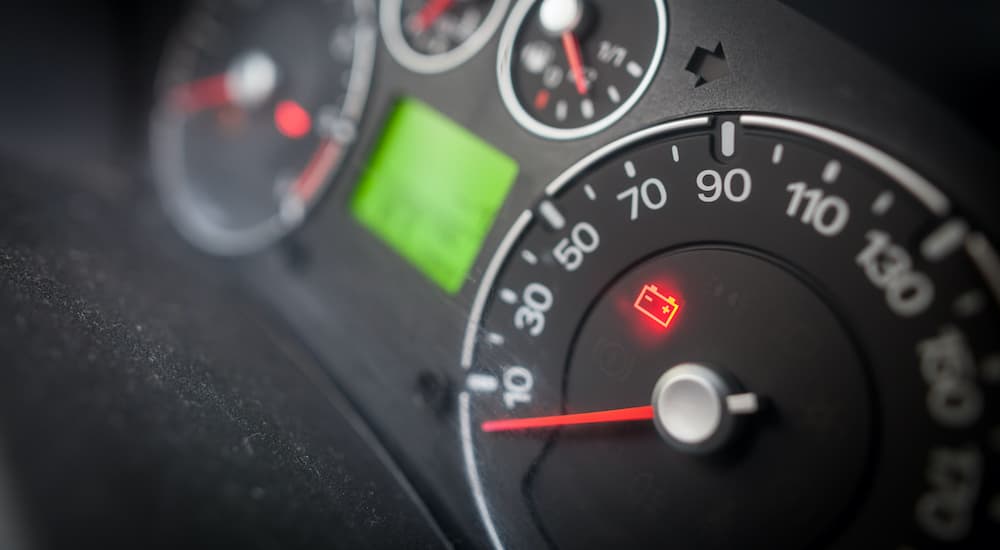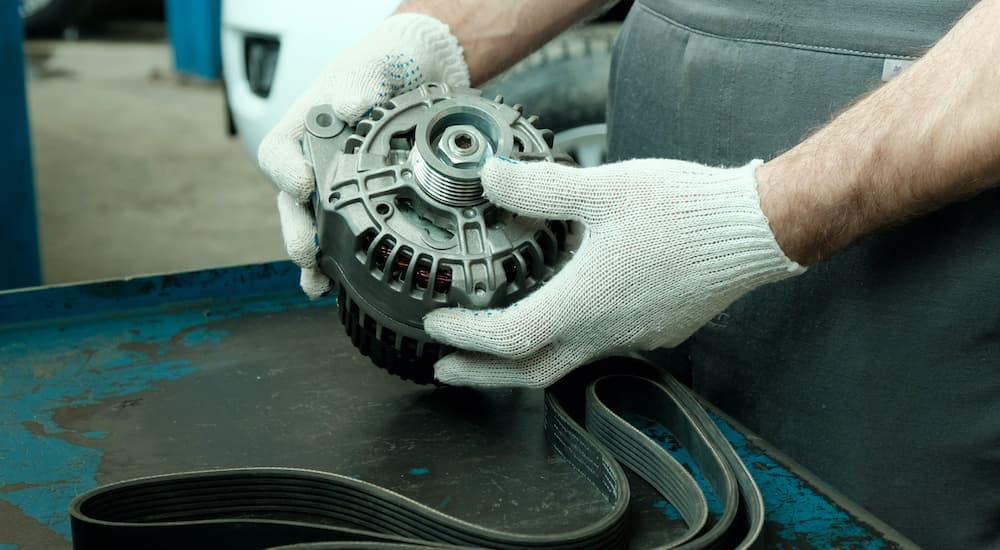From components as vital as headlights and power steering to less-than-essential features like your sound system and heated seats, there are few parts of your vehicle that aren’t somehow reliant on an electrical current. While we might understandably assume that it’s the 40-pound battery under the hood that’s keeping our phones charged and favorite tunes pumping through the sound system, it’s a lesser-known part that’s actually to thank – the alternator. The humble alternator, a coconut-size hunk of metal, plays a huge role in any vehicle’s electrical system but remains a mystery to many casual drivers. So before visiting Nissan service to fix your battery, stop and consider your alternator. With electrical systems such as driver assist, infotainment technology, and navigation becoming more ubiquitous, the alternator is a more vital component than ever before. Given this trend, it’s probably a good time to start asking ourselves: how does an alternator work, and when do you need to replace one?
A Little Background
Let’s get this out of the way right off the bat: an alternator has nothing to do with starting your car. The car battery, that leaden box under the hood that gives you trouble on cold mornings, is fully responsible for that task. Car batteries are essentially designed to generate one big electrical charge necessary to power the starter and get the engine moving; a one-trick pony that, while essential, has very little to do once the engine is up and running. From that point on, it’s the alternator that handles most of the electrical duties as you’re cruising down the road.
An alternator is essentially just a small generator. Usually mounted to the front of an engine, it’s powered by a serpentine belt connected to the vehicle’s crankshaft. As the engine runs, this belt spins the alternator’s rotor, which creates a magnetic field as it passes over copper wiring housed inside the alternator. This produces an electrical charge which is captured, fed into a voltage regulator, and then distributed throughout the chassis to power a number of vital systems.
The car also uses the alternator to recharge the battery itself anytime the engine is running. By feeding the alternating current (AC) produced by the alternator through a rectifier, it’s converted to the type of direct current (DC) power needed to charge a car battery. This tops off the battery to ensure you have the jolt you need every time you turn the key.
Signs of a Bad Alternator
If everything is working as it should, you’re unlikely to stop and consider the performance of your alternator, which should last a decade or more in typical conditions. There is no fluid to check and no regular maintenance to perform aside from replacing a worn serpentine belt. Still, there are a few telltale signs of an alternator on the fritz, so let’s dive into some of the most common warnings.
#1 – Vehicle Won’t Start
This one is pretty obvious. You turn the key in the ignition, and the engine either fails to turn over at all or gives a few wheezing attempts before sputtering out. As discussed above, the alternator plays a vital role in recharging your car’s battery, and if it’s not functioning as it should, the battery won’t have enough power to get things running. While this problem could also easily indicate a dead car battery, there is one foolproof way to help isolate the issue: grab some jumper cables and a friendly-looking stranger and jumpstart the vehicle.
Once your car is up and running, immediately disconnect the jumper cables – if the engine conks out, you’ve got a faulty alternator that’s not working well enough to keep the battery charged. If, on the other hand, the engine continues to run well after the cables are disconnected, you’re likely dealing with a depleted battery that has either reached the end of its life or is struggling with low temperatures.
#2 – Vehicle Barely Starts or Stalls Out
Maybe your engine does start; it’s just a bit of a touch-and-go experience at times. Your repeated attempts to get the motor turning over are eventually successful, but only with some patience and a couple of muttered curses. This could indicate a failing alternator nearing the end of its life that can still produce some power, but not consistently. This problem could manifest in another distinctive way as well: frequent stalling. This is because the alternator is not providing the spark plugs with adequate, well, sparks to keep the pistons firing, resulting in reduced engine performance and spotty power distribution.

#3 – Battery Light Is On
Our vehicles are generally good at letting us know what’s wrong, but it’s important to remember that English isn’t their first language. Relying on a series of icons, flashing lights, and gauges usually get the message across pretty well, but sometimes this simplified, symbol-based mode of communication can leave some room for misinterpretation. The dashboard battery light, for example, doesn’t mean the issue is limited to the battery itself and could signify issues with multiple parts of a vehicle’s electrical system, including the alternator.
A malfunctioning or broken alternator might not be able to deliver the expected voltage to the system – or even deliver too much – which could trigger a warning light. It’s not always a solid light either: if a vehicle’s electrical demands fluctuate as, say, the windshield wipers or air conditioning are engaged, the battery light could well flicker off and on. Either way, these lights are not to be ignored and are best diagnosed by an expert before the symptoms spread to more vital components that could have you calling a tow truck.
#4 – Dim or Bright Lights
While most vehicles have a dashboard battery icon that indicates general battery health, there are also a number of alternative signs for diagnosing alternator-specific problems. A failing alternator won’t produce consistent voltage, causing some weird fluctuations in the performance of various electrical components. This is often reflected in a vehicle’s head or tail lights, which might produce dim or excessively bright light when the alternator is about to bite the dust.
#5 – Accessory Malfunctions
As we discussed earlier, the alternator is the powerhouse for everything short of actually starting your car. Given this role, it’s not tough to pick up on the little signs that your alternator might be on the way out, provided you know what you’re looking for. Accessories that aren’t receiving enough power might work slowly, unevenly, or not at all. These include power windows and seats, windshield wipers, sound systems, and any number of interior lights.
Luckily today’s vehicles are pretty smart and will route power to essential components when inconsistent voltage starts to plague the system. This means your failing seat warmers and radio will let you know that something’s up well before your windshield wipers or power steering stop working.
#6 – Noises
Much like the beloved family dog, your car is good at letting you know when something is wrong by utilizing a strikingly similar system of groans, whines, and growls. These noises could be the result of the alternator’s serpentine belt rubbing against the pulley or getting jostled out of position. They could also indicate worn bearings in the alternator’s rotor shaft and, in any case, should be examined by a professional.
#7 – Smells
The smell of a malfunctioning vehicle, while often unpleasant, can be a useful diagnostic tool. The odor of burning rubber is a strong indicator that your alternator’s belt is nearing the end, either because of excessive friction, tension, or prolonged exposure to high engine temperatures. Burning rubber is a familiar smell to any fans of NASCAR or empty parking lot donut sessions, so this one should be easy to recognize.
One other distinctive smell you might catch a whiff of is that of an overworked or damaged alternator itself. When the wires inside the housing become frayed or damaged, they can emit a strong burning odor similar to that of an electrical fire. While the belt can be replaced or tensioned at home, the latter issue is best assessed by a professional as it requires a complete disassembly of the unit.

Don’t Wait Until You Lose Power
Note that while these signs are useful to help diagnose a problem with an alternator, they aren’t always fixes that can be performed at home, so be prepared for a trip to your trusted local auto technician. A quick visual inspection of the alternator’s belt is the most obvious form of diagnosis, with burned or warped rubber a clear indicator of a loose belt. This can often be solved by tightening with the tensioner, though be mindful of not over-tightening it, which could lead to further problems. Alternator repairs and replacements run the gamut based on specific makes and models, generally ranging anywhere from $200 to $1,000. This is not the easiest check you’ll ever write, but a failing alternator is far from the worst your vehicle can throw at you.

